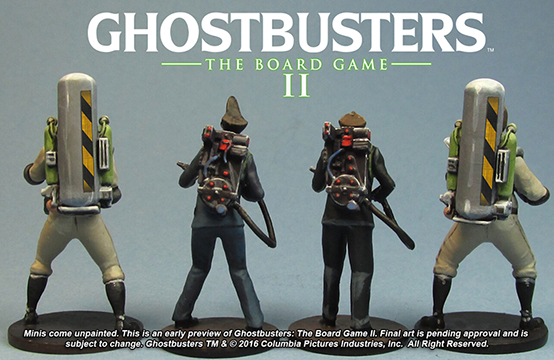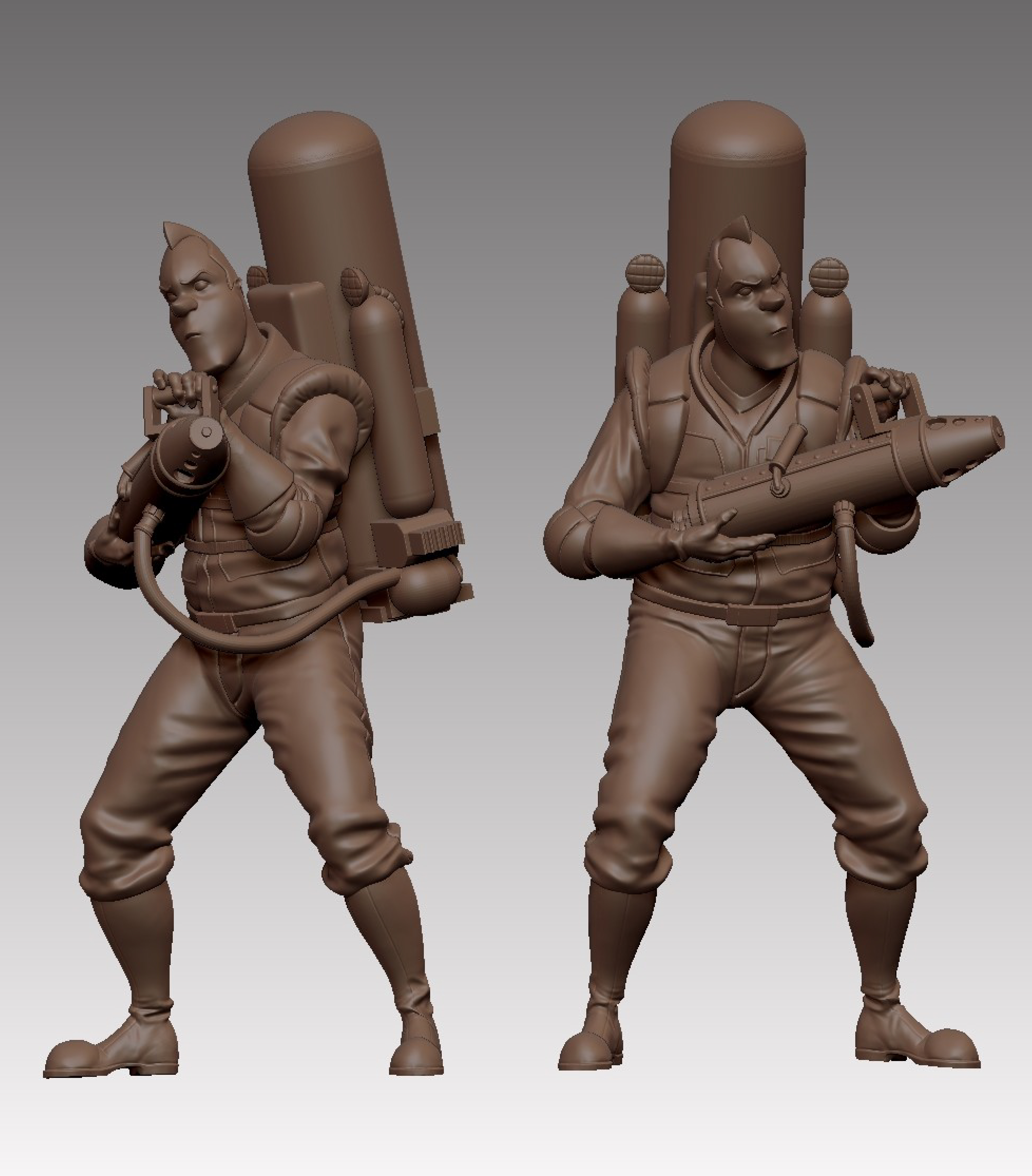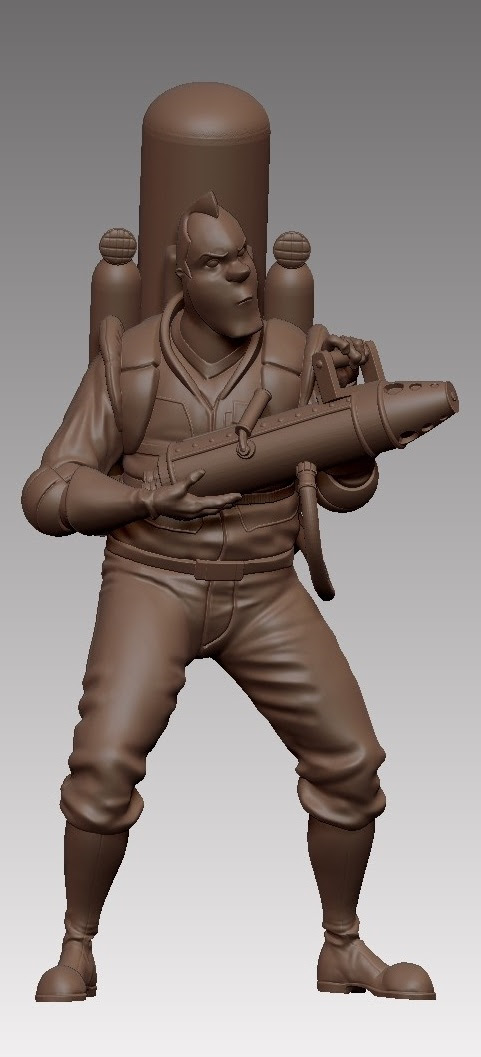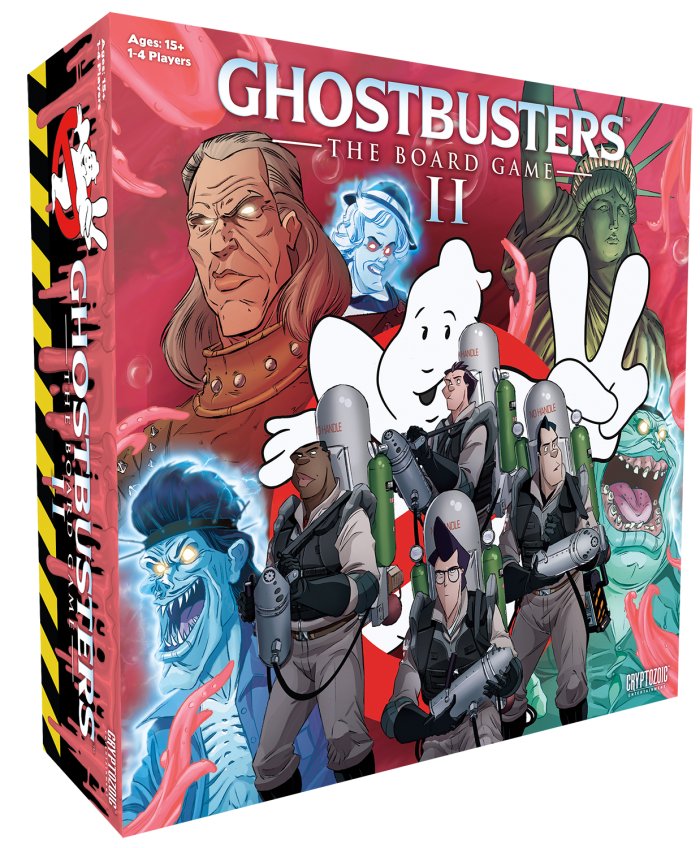Cardboard Cinema: The Designer Of 'Ghostbusters: The Board Game' On How You Adapt A Franchise And The New Sequel Game
Cryptozoic's Ghostbusters: The Board Game was a gigantic success on Kickstarter, raising over $1.5 million from gamers and movie fans who wanted to relive one of the most beloved franchises of all time. But since the original Ghostbusters film went on to inspire a sequel, a reboot, several cartoon spin-offs, a video game, and more than its fair share of toys, a tabletop follow-up was inevitable. Today, Cryptozoic launched the Kickstarter for Ghostbusters: The Board Game II, a standalone game that can be played by itself or in combination with the original game.
I had the opportunity to speak with Mataio Wilson, the lead designer on Ghostbusters: The Board Game and its sequel, about what it's like to adapt a beloved movie into a tabletop experience, how his past history with Dungeons & Dragons inspired this game, and what the sequel will bring to the table for experienced players and newbies alike.
Before you dive into my conversation with Wilson, you can watch the Kickstarter video for Ghostbusters: The Board Game II below and head over to the project's page, should you decide to back the game. Naturally, backers will receive bonus stuff that won't be available in the final retail version.
And here's the official press release, which runs down the basic details:
Cryptozoic Entertainment (cryptozoic.com), leading creator of board games, trading cards, and collectibles, and Sony Pictures Consumer Products are proud to announce today's launch of the Kickstarter campaign for Ghostbusters: The Board Game II.
This new campaign, on Kickstarter today, is crafted with fans in mind and includes the following contents in the base game: 54 Miniatures including 4 Courtroom Ghostbusters, 4 Slime Blower Ghostbusters, The Scoleri Brothers and Vigo the Carpathian plus 12 double-sided map tiles, custom dice and tokens, some of which can be used for advanced gameplay variants. Two expansions starring Louis Tully and Slimer as playable characters are also available for backers starting today.
Ghostbusters: The Board Game II features an original story by IDW Comics' Ghostbusters writer Erik Burnham in which Vigo and his minions return to the city, causing rioting and earthquakes to break out all over The Big Apple! Comic book artist Dan Schoening also returns with his signature Ghostbusters style. Ghostbusters: The Board Game II's cooperative gameplay and modular design allow for highly customizable scenarios and nearly endless re-playability. This stand-alone expansion lets players hop in the Ecto-1a for a quick half hour session, or strap on their Proton Packs for a full-fledged ghostbusting campaign, making it the perfect game for board game veterans and beginners alike.
This interview has been edited for length and clarity.What's your personal history with the Ghostbusters? Were you a fan first or were you a designer who just landed a job?
I was a huge fan. Despite seeing both movies repeatedly, I also grew up in the '80s and the '90s so I got to watch The Real Ghostbusters, The Extreme Ghostbusters, and Slimer! with Dr. Dweeb. I read all of the comic books and owned all of the toys. I was already a super-fan when I joined the company and it was on my second day at Cryptozoic when they said "Hey, we're working on a Ghostbusters game, do you want to take a crack at it?" And I just tried to bite my lip and not pee myself and I dove right into it. I was so excited because I had so much history with the franchise, but I didn't know what was available. But when I was informed that Sony gave us open license and we could have anything we wanted, this was before the new movie was announced, I was able to dig as deep as I wanted. I didn't have to cut my imagination off anywhere.
Is there a board game pitching process? Do different designers come forward with different takes?
There are different processes depending on the property or the timeframe that we have. Sometimes it's presented to us as license where we have all of these different avenues we can take with the property, from merchandise to games to trading cards. If we can't come up with something good enough, we just don't do it. We'd rather not put out something we're not proud of just to fill a hole. When they first had the board game opportunity and I first joined the company as a contractor, there was already a dozen iterations of the game. It just wasn't falling into a place that we were happy with yet. When I took it on, it wasn't with the assumption of, oh sweet, this will be the game, it was that I had to make a game that I enjoy playing that will look like a commercially successful game that the fans will like and an introductory board game people will like and people who play board games will like as well. We had all of these different avenues to look at. One day, we got word that we could move forward with a Kickstarter version of it. That usually changes the project's size from "What's the max we could put into it and shave everything around the edge?" to "What's everything that you could possibly think of?" Kickstarter will give us the opportunity to put everything that's good in the game that we had to leave out because of size and shipping.
When I started working on it, it was about what kind of game I would like to play with the Ghostbusters. And when I look at the Ghostbusters and think about the games I enjoy, they fell into an RPG-party type of system. You had someone who could get the attention of a target, like Peter Venkman, shouting at ghosts or taunting them. We had a healer in the Ray character, who collects the slimes and is super curious. We have Egon, who is great with equipment and can build things. And we have Winston, who is like our support class character. With those in mind, we restructured the game so that the experience you had also worked from scenario to scenario in a big campaign. It's not just sitting down for an hour to play a game and restarting it the next time you play. It would carry the experience from game to game to game so you could form a bond with you character and feel that you're actually being part of the situation.
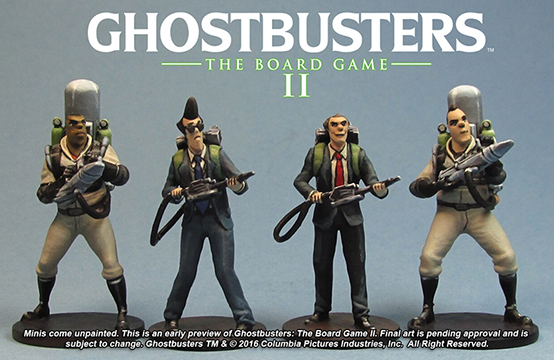 The game is set up like a dungeon crawler, looking a lot like Descent or Zombicide. Before you landed on the RPG angle, did you consider any other styles? Maybe something like Pandemic?
The game is set up like a dungeon crawler, looking a lot like Descent or Zombicide. Before you landed on the RPG angle, did you consider any other styles? Maybe something like Pandemic?
Some of the early versions were going for a nice card game, where we would take some of the classic tropes of card games, but they weren't hitting that sweet spot of "I'm a Ghostbuster and we're busting ghosts and we're tracking down a big villain at the end of a fight." When we were first looking at it, it was a one big map type of a game and you fought your way through it and that was that. That's the end of it. We could create lots of different settings and scenarios and game types, but it didn't feel like, at the end of it, that you had progressed to a point where the game felt like it could keep going on after that. For me, that's what Dungeons & Dragons is all about. The feeling that the game is never over, that your characters can always do more. Unless your Dungeon Master kills your characters. You could always feel that "After that, what's next?" as opposed to "Let's try that again in a different way." We wanted to find that space where you felt that if you kept playing this, will it feel like I'm just starting over again or will it feel like I'm just continuing the storyline.
A lot of the game's mechanics, like being slimed, are directly inspired by the movies. Did you just watch them over and over again and make a list of things you knew had to be woven into the game? How do you translate stuff like that into satisfying game mechanics?
Luckily, we already had the movies at the forefront of our memory when we started, but we did sit down to watch it over and over again. We would stop at certain scenes and make notes and talk about it. How can we capture that flavor without being a mirror of exactly what it is? One of the first things we arrived at was that we didn't want to make a recreation of the movie. We didn't want it to be "Remember that scene where the Ghostbusters did that thing? Now you're doing that thing!" Because we know how that plays out. When video games do that on-rails effect, you feel like you can't possibly lose. Instead, we wanted to build a creative storyline, working with Erik Burnham who does the IDW comic books, which we took a lot of inspiration from. We worked with him to figure out a plot. If these four Ghostbusters were back in the world, what would their motivation be? Their goals? Why are these ghosts dangerous and why do we need to bust them? From there, we were able to create situations that were similar to ones you saw in the movie so you'd have that nostalgia feeling without having a step-by-step reflection. We wanted you to have something new that still felt like you were in the same universe. Luckily, we also had the toy lines, TV shows, comic books and even the video games to touch on and pull inspiration from.
I think a lot of people who consume entertainment have a very basic idea of how film directing and screenwriting work, but most people don't know anything about board game design as a process. How does the job work, exactly?
I take a lot of inspiration from movie and TV and entertainment in general. I look at certain beats. A movie's beats is trying to take me through an emotional journey and put me in the shows of a character. Show them growing and overcoming obstacles and things like that. We want to represent that as well. Instead of just saying here's the game and try to get from point A to point B, we're trying to build memorable moments throughout the gameplay and put a spotlight on those. When I play a game and talk about it afterwards with my friends, it's not every little thing we did. It's the big things and the memorable things and dramatic things. So when we're looking at the game design, I'm looking for those emotional impact points that I can poke at over and over again until we reach a crescendo. Then it plateaus and we have a steep drop-off and then we can take it back up again. It's like a roller coaster or a wave of feelings.
The actual mechanics and minutiae process of it is like any kind of writing exercise. You sit down and make up a skeleton of what you want the story to be and what you're trying to express and then you break it down by how much time each things take. If some things take too long, you have to have a discussion about what's more important, the mechanics or whether [players] understand what they're doing. If we have a really wonderful idea we want to express but we're having a really tough time expressing it, then we have to change the way we're describing it or change the thing itself. Most of the time, we try to make the way we're expressing it shine out better so we can keep the great element of the gameplay. For Ghostbusters, we wanted make sure it was an episode and in a campaign mode. We wanted each scenario to be around an hour so you could have one hour at a time or four hours for an entire gameplay session. For my old D&D times, four hours was pretty average. Sometimes eight, if we pulled an all-nighter. With Ghostbusters, we wanted to make sure we had those same touchstones, like those moments in a Super Mario Bros. level where you hit the flag in the middle of level and it's like, "Cool, we can take a breather here," and then keep on moving from there.
We had so many things that we wanted to cram into the game and Kickstarter allowed us to make a great retail game to begin with and really build on it by taking the script that we had and instead of just stopping where we felt like the movie would end, we could keep going and keep building. We would use Excel sheets and Google docs to share information between all of the departments to make sure that everyone was in line with what we were trying to spell out. But a lot of it was just iteration. You roll the dice. How does that feel? The play testers give us the feedback that we need. If we put down the expectations that we want them to do a certain thing and they go a different direction, we have to weigh that. Is that more important? That they had more fun doing it the wrong way? Or is it more important that we had to remind them over and over again how to do it the right way. A lot of the time, we tried to do it their way, even if it was our wrong way. We would just try to make it the right way. What's nice about Kickstarter is that in the comments section, people can read the rulebooks and look at the scenarios and give us their issues with it and we can fix them on the spot. With a retail game, if something goes wrong, you don't hear about it until months after it comes out.
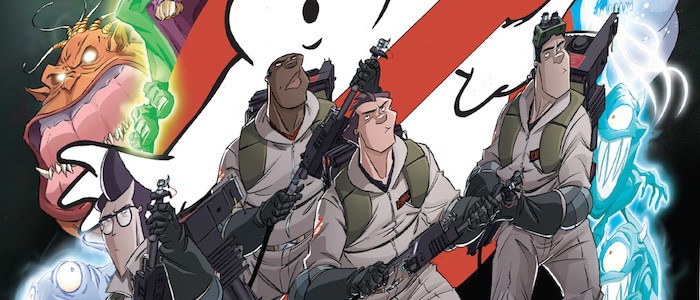 When you play test a game like this, do you focus on hardcore gamers, Ghostbusters fans, or casual gamers? Do you mix and match personalities to make sure everyone is enjoying it?
When you play test a game like this, do you focus on hardcore gamers, Ghostbusters fans, or casual gamers? Do you mix and match personalities to make sure everyone is enjoying it?
For Ghostbusters, it was really important that we pick good groups. We have a good amount of people that come in on a weekly basis just to play all of our games, but for Ghostbusters, I was specifically looking for super-fans who had seen the movies a lot of times and were familiar with the cartoons and comic books, board gamers, who could rules-lawyer and break the game, and people who weren't familiar with the movies and didn't play board games. We try to mix those people up. If we had too many of one type, we would get really different reactions and the game would take very different directions from week to week. If we had the Ghostbusters thematic people and they said "I like how that felt, I felt like I was a Ghostbuster," we could say we hit that cylinder. If the board gamer said it was deeply layered enough but not so complex that they couldn't teach their children, we'd be like cool, we got that one. For the introductory board game people, if they said that people could teach them what it was and they figured it out in a couple minutes, we felt like we landed in the right spot. There were weeks where we'd get nothing but hardcore gamers or movie fans and we'd have to take their opinions with a grain of salt. They sometimes want to push it in a certain direction and we need to find a sweet spot where retail and [fandom] meets.
The character and ghost sculpts in the game in the game are gorgeous. Is that the kind of extravagance that you can get away with on Kickstarter that you couldn't do if you published it normally?
Some of it. We had to get our artist to do 2D sketches, which were done by Dan Schoening, who is the IDW Ghostbusters comic artist. We never had to think "Does this look like Ghostbusters or have that Ghostbusters feel?" because we knew it was coming from one of the major creators. When we created sculpts for the 3D version, we were able to pass those around as well. Sometimes, you only get a forward facing 2D image and you have to use your imagination for what the back of that looks like. Luckily, the movie spells that out. You see them walking around and you see them doing a lot of things. The video games already had a lot of 3D imagery that we could rotate and look at anything we wanted to. When it came to the ghosts for instance, the toys were like 3D plastic molds. They were just pressed out. Then we looked to Dan Schoening's DeviantArt page, where we got a lot of our inspiration for which ghosts to use. He would show them in his style...this is what they would look like. He would design them in a different pose so it would be balanced and wouldn't fall over as a [miniature] or it could fit on a base. We would then pass that off to the 3D artist, who was usually right on.
Like with any kind of art, there were passes back and forth where we make tiny critiques and tiny suggestions. Once it falls into that spot where we don't notice anything wrong or the artist has taken some liberties and added some things that really help out the character, we know we're good and ready to move on. I'm a miniatures fan and collector, so I'll admit it, when I look at a Kickstarter, the first thing I look at is the quality of the figs. Then I'll look at the quality of the gameplay. A game may be amazing, but if you're constantly squinting your eyes at it, it's harder to be fully immersed into the amply itself. It's a lot harder to sell the moment you're in. We were looking at all of the figs coming back and not only did they look similar to the toys, but they just had a good presence on the board. That's what we're trying to hit the ground running with on this next one. Kickstarter allowed us to incrementally increase our budget, so we were able to go back to our 3D artist and say "Remember all of those pieces we front-loaded and didn't have the budget to ask you to do? Now we have the budget to ask you to do it. Go ahead and churn those out." We would do updates to show new 3D art as it came through. Even during that process, players could say something like "I don't like the way that guy's waving his arm" of "That character shouldn't have teeth that jagged," we had the opportunity to go back and make those little changes.
What's new in the box for Ghostbusters: The Board Game II? What can gamers look forward to seeing?
There were many elements from the first game that we thought would be too heavy or complex for an introductory board game, so we had to hold some things back. This time, we actually got to spend a lot more time balancing those things out. The more time we can have working on something, the better. This time around, we introduced the equipment cards. So now when people ask about the Ecto Goggles, we now have the Ecto Goggles in there. We have a lot of fun items. The equipment is broken down into four categories: weapons, traps, utilities, and tomes. Tomes will let you do impossible things like teleport around or remove slime from across the board. Utility helps you do a thing or buffs you for a round to help you do that thing. Traps help you trap ghosts right away or give you a benefit when you do trap a ghost. Weapons are combat-based. They give you a free attack or bonuses to your attacks.
A lot of things people would ask for, like how they could get a plus to attack...in the first game, it's all dice-based and there are no modifiers. Modifiers can often unbalance a game if you don't have the monsters and characters leveling up at the same time. In the first version of the game, we didn't have the ability to level up a ghost because of tracking issues. If you say that one blue ghost is level one but the exact same ghost next to it is level two, it was too hard to tell the difference. We couldn't figure out a way to do that. This time around we have bases that can be snapped on to the bottom of ghosts. That lets us add new abilities to them. In the first game, we did Impossible Mode ghosts, where we printed out the characters in red instead of blue and we added new stats to them and gave them a whole new character card. While that was fun for collectors, the people who didn't get it or purchased the retail version never got the opportunity to do that.
With the new base game, for Ghostbusters II, we have this plastic bases of many colors that when you snap them on a ghost, it gives them a brand new ability that makes them tougher to trap or track down or they can move faster. A lot of the things that we had tracking issues with could be resolved with bases. Besides equipment cards, we now have an event card. In a classic RPG, you would have random things happen to you while on the road. You'd be walking down the street and goblins would jump out at you or you'd be attacked by a necromancer.
So in Ghostbusters II, we were able to introduce these event cards. When you're searching goo piles, which are these big piles of slime on the ground, you can find equipment, an event, or a key item that helps you solve the mission, defeat a boss, or get through a certain area. An event will trigger and give you a certain number of player actions or rounds to resolve it. Some of the more simple things it can do is release more ghosts or it can cover people in slime and you need x number of rounds to remove it. If you do the thing it's asking of you, you get a group-wide bonus like more speed or remove some slime or get some free moves. Or something bad will happen, like a different kind of ghost will come out or you'll get a curse of some kind or you'll get moved around the map or you won't be able to take certain actions for a certain amount of time. So while you're doing the basic scenarios of just going through and finding the major objective, you'll have these miniature objectives. Not much is random. You choose when you get to search the pile, but you don't know if it will be an equipment card, which you can use for free at any time during your turn, or this event that everyone needs to participate in.
We were also able to include new slime types. In the first game, every slime was just minus one action. In the new game, we expanded on the idea of slime types. In addition to minus action, slime can now reduce your line of sight, reduce how far you can move, and reduce your maneuvers and minor actions. We are also introducing a new kind of slime for people who thought the game was too introductory or too easy, which is caustic slime. This black slime can't be removed by any Ghostbuster and if you ever get three of these on your character, you just lose and the game is over. We wanted to make a hardcore mode built into the missions for when you were resting on your laurels and leveling up and using this new equipment. We can start to throw harder and harder things at you. In the first game, that was usually more ghosts and tougher gates. This time, we can modify the ghosts, modify equipment, and throw new types of slime at you.

